Cornhole is one of the funnest lawn games around and it’s only getting more popular each year. But a lot of people don’t know what the proper cornhole distance rules are for setting up their games.
This article will show you what the regulation distance is for a traditional cornhole match but it will also show you alternative distances you can use if you are a little short on real estate, whether you’re playing in a backyard or out at a tailgate.
Cornhole court
A regulation-sized cornhole court is 45 feet by 8 feet and should look something like this:

You want to do your best to make sure that your cornhole court is set up over a flattened area. Try to clear out any debris you might find or things like dog poo so you don’t step in it.
While flat ground is ideal, I’ve played some cornhole games on slightly uneven terrain before. It’s a bit of a nuisance when the board gets shaken by the uneven ground but it’s still doable so you don’t have to have a perfectly smooth cornhole court.
Also, you don’t really need 45 feet for a sufficient cornhole court. You just need enough room to have proper distance between the boards, which I’ll talk about below.
Get a quality cornhole board set right now!
Check out my #1 recommendation for a quality cornhole board set that is perfect for beginners.
Distance between the boards
There are different distances you can set up between your boards but I’ll start off with the official distance.
Official distance
The distance between the cornhole boards for a regulation game should be 27 feet, measured from the front edges of the cornhole boards.
The distance from the front edges of the cornhole circles should be 33 feet.
It’s usually easier to just measure the distance from the front edges of the cornhole boards so I generally recommend people to just make that measurement.
The diagram below will help you visualize what this distance should look like.
Tip: you can set up a string measured at 27 feet and attach it to the inside of your cornhole board for quick and easy measurements.
Distance for tailgating
When playing backyard or tailgate cornhole, it’s often the case that you have less real estate to play with.
For this reason a lot of people will play with a shortened cornhole court.
Generally, people will shorten the distance between the cornhole boards to 24 feet.
Distance for juniors and seniors
Juniors and senior citizens are usually allowed to play from shorter distances.
Typically, they will throw from 21 feet away from the cornhole board.
What constitutes a junior?
Many label kids under 17 as juniors but others might set that age even lower to 14 and under.
Senior citizens are usually aged 65 but it could vary.
Also, people with mobility issues or disabilities are usually allowed to toss from 21 feet.
Distance between cornhole courts
If you’re playing with multiple cornhole courts at once you want to make sure that you have enough distance between the courts so that you don’t interfere with other games.
It’s like in bowling when someone gets up to bowl right next to your lane and breaks your concentration.
So try to keep about 10 to 12 feet between cornhole courts as shown by the diagram below.
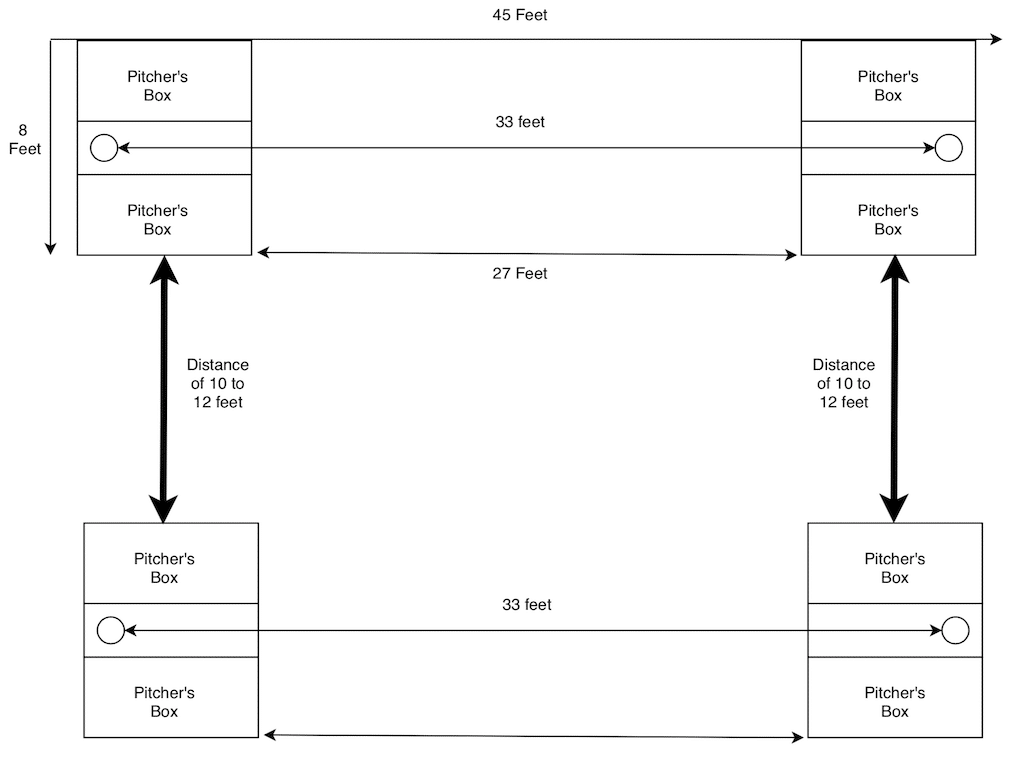
How much room is needed for cornhole?
A lot of people only ask how much room is needed between the cornhole boards but they forget to think about the total amount of room that will be needed factoring in the size of the cornhole boards.
Below, I’ll show you much space you’ll need to play a regulation cornhole game and also a few different ways that you can get by with less real estate.
Regulation cornhole boards and distance
Regulation cornhole boards are 4 feet by 2 feet.
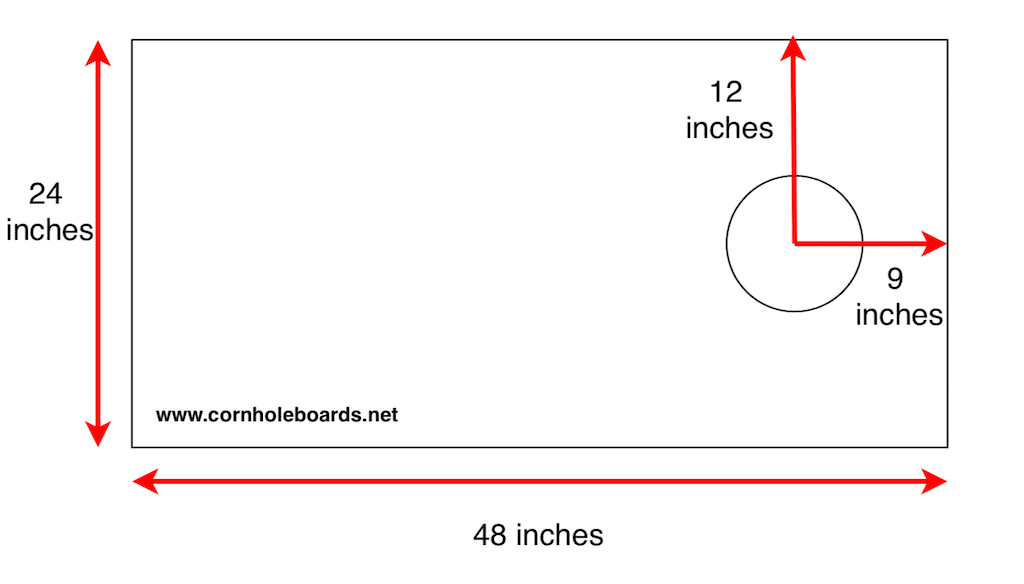 So if you add the distance of 27 feet to the length of a regulation-sized cornhole board you can see that you need 35 feet to have a full sized cornhole court.
So if you add the distance of 27 feet to the length of a regulation-sized cornhole board you can see that you need 35 feet to have a full sized cornhole court.
That extra eight feet is a lot and something you definitely want to remember to consider.
Regulation cornhole boards and tailgate distance
But if you’re playing from a shorter distance like 24 feet you only need 32 feet.
Tailgate boards
However, they do make smaller cornhole boards (tailgate sized) which are 2 feet by 3 feet.
If you’re playing with tailgate-sized boards then you only need 32 feet if you’re going to play with a full-sized regulation court.
But if you shorten up the court to 24 feet you only need 30 total feet.
But what if you still don’t have that much room?
If you are still pressed for room then you can always just play with one cornhole board. If your’e using regulation-sized cornhole boards then removing one board will save you four feet.
That can make a big difference if you’re stuck with a very small yard or playing area.
Where is the foul line?
The foul line is an imaginary line that runs in front of the cornhole board and in front of the pitcher’s box. Stepping over this line results in a foul, which means that you’ll get zero points for your toss.

When playing with juniors you’ll need to measure out 21 feet from the front of the opposing cornhole board so that you have an accurate foul line. You can use things like a tape measure, string, chalk, or whatever else you can find to mark the foul line at 21 feet.
Cornhole bags
Now that you know the correct cornhole distances for your cornhole courts, make sure you know what the proper sizes are for your cornhole bags.
According to the ACO, cornhole bags should abide by the following standards:
- Each bag is made from two fabric squares with double-stitched seaming.
- The bags should be made from a durable fabric like canvas, twill, or synthetic suede.
- Each bag measures roughly 6” by 6” and weighs 15 to 16 ounces
You can choose corn-filled cornhole bags or you can go with plastic resin filled bags. Both of them have their advantages and disadvantages.
Corn filled bags are great because they are traditional and produce a fine dust that aids with sliding. But they can invite pesky critters and mold if you don’t properly take care of them. They also will break down over time.
On the other hand, plastic resin pellets are great because they are usually weather proof and won’t break down like corn will. And you generally won’t have to worry about critter or animals getting into your bags.
They won’t produce the same type of dust though and sometimes they can be more inclined to bounce than corn-filled bags, depending on the filling amount.
You can read more about the corn-filled vs resin debate here.
Cornhole rules and gameplay
Cornhole is a very simple game and just about anybody can play, which is why it’s such a popular lawn game. You can read more on how to play cornhole here.
One on one
In one on one cornhole, each of the two players will stand in the pitchers boxes on the same side
The cornhole board in between them is called the “headboard” and the cornhole board they are throwing to is called the “footboard.”
The players will alternate pitches until each player has thrown all four of their bags.
After all of the bags are thrown, the score is calculated (more on that below) and then the players will walk down to the other cornhole board and repeat the process. Once the final bag comes to a rest, each player has 30 seconds to walk to the other end, pick up their bags, and get ready to make their pitches.
The player with the higher score will throw first and they will resume tossing their four bags. During the entire game, each player remains in their own lane.

Two on two
In two on two play, each team remains in their lane the entire game and the play is almost the exact same as described above.
The main difference is that the players never walk down to the other board since the those boards are already occupied by their team mates. So the players on each side just pick up the bags after the score is taken and then make their pitches to the other side. Rinse and repeat.
Once again, the team that score the most in that inning will go first the next inning. If neither player/team scores, the player/team who pitched first in the preceding frame shall retain first pitch in the next frame.
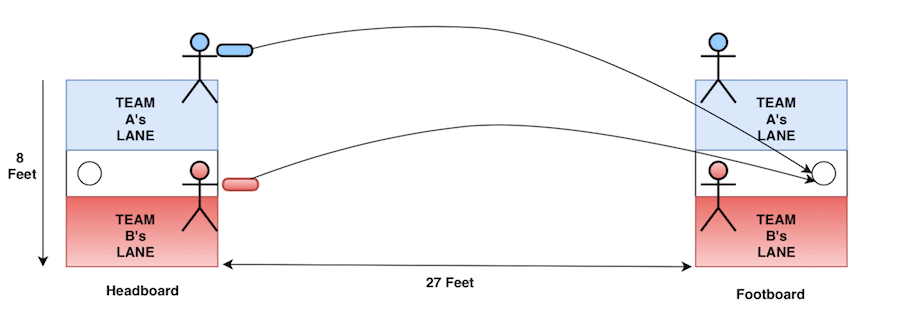
If you want technique tips for throwing cornhole bags then click here.
Get a quality cornhole board set right now!
Check out my #1 recommendation for a quality cornhole board set that is perfect for beginners.
Cornhole scoring
Cornhole scoring is a pretty simple process and there’s basically only three outcomes.
In cornhole you can score 3 points, 1 point, or 0 zero points on each toss.
Here’s what counts as a point:
- Cornhole (3 points) — when the bean bags passes entirely through the cornhole
- Woody (1 point) — when the bean bag lands on the playing surface of the cornhole board
- Foul (0 points) — any bean bags that is not a woody or a cornhole
(For an explanation of other cornhole terms click here.)
What counts as a woody?
When a bag lands directly on the playing surface, that’s a woody. Also, if the bag is hanging off the board but it’s not touching the ground that is also a woody.
And finally, if the bag is hanging partially over the hole but not all the way in the hole, that’s a woody (unless you can prove that bags piled up on the inside of the hole are preventing it from falling in).
What counts as a foul?
Here’s what constitutes a foul
- You step over the foul line (at least one foot or appendage must be completely inside the pitcher’s box at the time of release)
- Throw from the wrong pitcher’s box (many don’t follow this rule)
- A bag hits the ground — if a bag hits the ground and then makes its way on to the cornhole board, it’s a foul
- Lands on the ground — any bag that comes to rest touching the ground and the board is a foul.
- Hits something else besides the board — if your bag hits a tree, power line, ceiling, etc. then that it s a foul bag.
- Take too long to pitch — Any bag not pitched within the 15 second time limit is a foul bag.
The cancellation method
The official way to score cornhole is with the cancellation method.
With this method, only one team or player scores points each inning/frame.
So for example, let’s say a frame goes like this:
- TEAM A scores 2 cornholes and 1 woody so they get 7 points.
- TEAM B scores 3 cornholes and 2 woodies so they get 11 points.
In that case, you subtract the lower score from the higher score so that at the end of the frame, TEAM B has 4 points (11 minus 7) and TEAM A has 0 points.
Some people struggle to keep score during their games so they rely on things like cornhole scoreboards to help them out. There are tons of different types of score boards — my favorite are the ones that come with drink holders.
You can find out more about these and other cornhole accessories here.
How to determine a cornhole winner
There are quite a few different ways to crown the cornhole winner.
The most popular way is to crown the winner based on who reaches a score of 21.
You can play where the winner is crowned as soon as he or she hits 21 (even if it’s in the middle of the inning) or you can play where the other player/team has to get the chance to throw their bags as well.
Other ways to determine a cornhole winner are:
- Winner has to score exactly 21 and if you don’t then you go back to 15 or 11
- Winner has to win by two
- First one to 11 wins
I prefer playing where the first person to reach 21 wins as the games tend to be the perfect length of time — not too long or too short. I also don’t like to cut the game off mid-inning, so that there can be a chance to tie.
Many people also play 7-0 skunks so if one player gets ahead 7 to nothing, it’s declared a skunk and the player with seven points wins.
Final word
As you can see, there are many different cornhole distances you may want to utilize depending on how much room you have and the age and skill of your players. Try out different distances and I recommend just going with the one that is the most fun for everyone unless you’re trying to keep things very official.

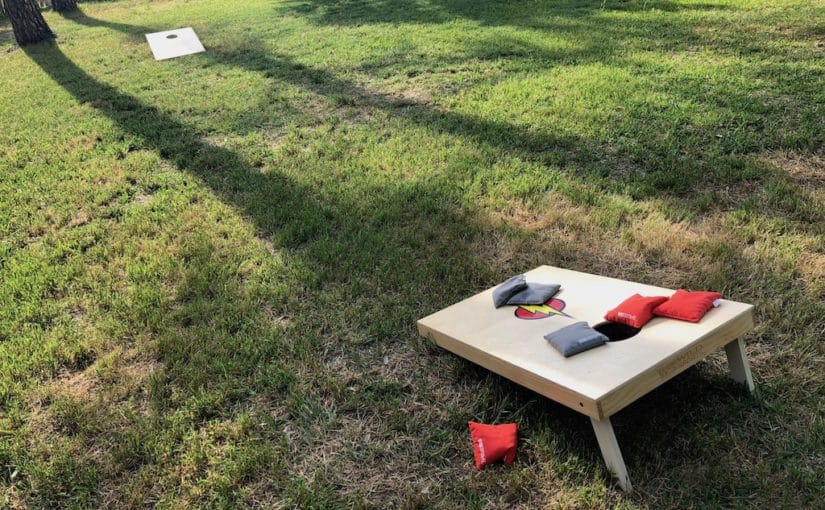
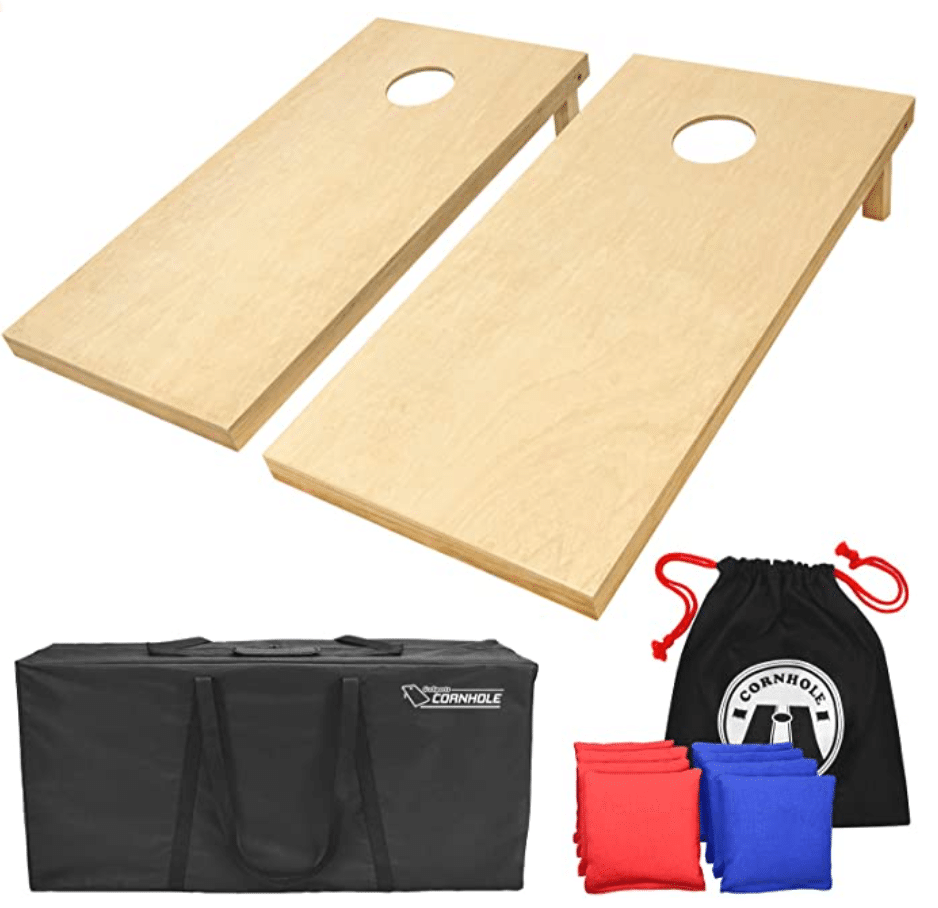
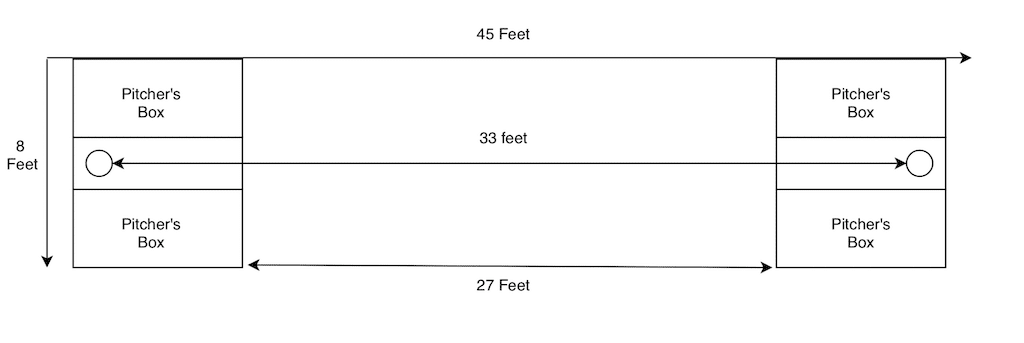
If your bag is on the board ( a woody = 1 pt). Now if either you or your opponent knocks that other bag into the hole. How do you score that bag now going thru the hole?
Thanks
Scott